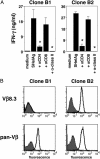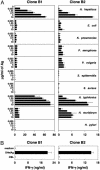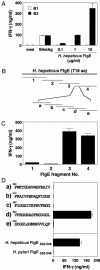Induction of colitis by a CD4+ T cell clone specific for a bacterial epitope
- PMID: 14673119
- PMCID: PMC307653
- DOI: 10.1073/pnas.2534546100
Induction of colitis by a CD4+ T cell clone specific for a bacterial epitope
Abstract
It is now well established that the intestinal flora plays an important role in the pathogenesis of inflammatory bowel disease (IBD). However, whether bacteria serve as the sole target of the immune response in this process or whether they act indirectly by triggering an anti-self response is still unclear. We have previously shown that specific pathogen-free IL-10-deficient (IL-10 KO) mice develop a T helper (Th1)-cytokine associated colitis after experimental infection with Helicobacter hepaticus. We here show that H. hepaticus Ag (SHelAg)-specific CD4+ Th1 clones transfer disease to H. hepaticus-infected T cell-deficient RAG KO hosts. Importantly, uninfected recipients of the SHelAg-specific clones did not develop intestinal inflammation, and a control Schistosoma mansoni-specific Th1 clone did not induce colitis upon transfer to infected RAG KO mice. The disease-inducing T cell clones recognized antigen(s) (Ag) specifically expressed by certain Helicobacter species as they responded when stimulated in vitro with H. hepaticus and Helicobacter typhlonius Ag, but not when cultured with Ag preparations from Helicobacter pylori, various non-helicobacter bacteria, or with cecal bacterial lysate from uninfected mice. Characterization of the Ag specificity of one of the clones showed that it reacts uniquely with a 15-mer peptide epitope on the flagellar hook protein (FlgE) of H. hepaticus presented by I-Ab. Together, our results demonstrate that colitis can be induced by clonal T cell populations that are highly specific for target Ag on intestinal bacteria, suggesting that an aberrant T cell response directed against gut flora is sufficient to trigger IBD.
Figures





Similar articles
-
Bacteria-triggered CD4(+) T regulatory cells suppress Helicobacter hepaticus-induced colitis.J Exp Med. 2002 Aug 19;196(4):505-15. doi: 10.1084/jem.20020556. J Exp Med. 2002. PMID: 12186842 Free PMC article.
-
Helicobacter hepaticus-induced colitis in interleukin-10-deficient mice: cytokine requirements for the induction and maintenance of intestinal inflammation.Infect Immun. 2001 Jul;69(7):4232-41. doi: 10.1128/IAI.69.7.4232-4241.2001. Infect Immun. 2001. PMID: 11401959 Free PMC article.
-
Helicobacter hepaticus triggers colitis in specific-pathogen-free interleukin-10 (IL-10)-deficient mice through an IL-12- and gamma interferon-dependent mechanism.Infect Immun. 1998 Nov;66(11):5157-66. doi: 10.1128/IAI.66.11.5157-5166.1998. Infect Immun. 1998. PMID: 9784517 Free PMC article.
-
Effector and regulatory CD4+ T cell function in a murine model of Helicobacter hepaticus-induced colitis.J Pediatr Gastroenterol Nutr. 2005 Apr;40 Suppl 1:S35-6. doi: 10.1097/00005176-200504001-00021. J Pediatr Gastroenterol Nutr. 2005. PMID: 15805844 Review. No abstract available.
-
Helicobacter hepaticus infection in mice: models for understanding lower bowel inflammation and cancer.Mucosal Immunol. 2011 Jan;4(1):22-30. doi: 10.1038/mi.2010.61. Epub 2010 Oct 13. Mucosal Immunol. 2011. PMID: 20944559 Free PMC article. Review.
Cited by
-
Complex Microbiota in Laboratory Rodents: Management Considerations.ILAR J. 2020 Oct 19;60(2):289-297. doi: 10.1093/ilar/ilaa011. ILAR J. 2020. PMID: 32706377 Free PMC article.
-
Intestinal microbiota composition of interleukin-10 deficient C57BL/6J mice and susceptibility to Helicobacter hepaticus-induced colitis.PLoS One. 2013 Aug 9;8(8):e70783. doi: 10.1371/journal.pone.0070783. eCollection 2013. PLoS One. 2013. PMID: 23951007 Free PMC article.
-
T Cell Proliferation and Colitis Are Initiated by Defined Intestinal Microbes.J Immunol. 2018 Jul 1;201(1):243-250. doi: 10.4049/jimmunol.1800236. Epub 2018 May 18. J Immunol. 2018. PMID: 29777027 Free PMC article.
-
Dysbiosis exacerbates colitis by promoting ubiquitination and accumulation of the innate immune adaptor STING in myeloid cells.Immunity. 2021 Jun 8;54(6):1137-1153.e8. doi: 10.1016/j.immuni.2021.05.008. Epub 2021 May 28. Immunity. 2021. PMID: 34051146 Free PMC article.
-
Deciphering interactions between the gut microbiota and the immune system via microbial cultivation and minimal microbiomes.Immunol Rev. 2017 Sep;279(1):8-22. doi: 10.1111/imr.12578. Immunol Rev. 2017. PMID: 28856739 Free PMC article. Review.
References
-
- Strober, W. & Ehrhardt, R. O. (1993) Cell 75, 203-205. - PubMed
-
- Powrie, F. (1995) Immunity 3, 171-174. - PubMed
-
- Sartor, R. B. (1997) Am. J. Gastroenterol. 92, 5S-11S. - PubMed
-
- Gionchetti, P., Rizzello, F., Venturi, A., Ugolini, F., Rossi, M., Brigidi, P., Johansson, R., Ferrieri, A., Poggioli, G. & Campieri, M. (1999) Eur. Rev. Med. Pharmacol. Sci. 3, 27-30. - PubMed
-
- Campieri, M. & Gionchetti, P. (1999) Gastroenterology 116, 1246-1249. - PubMed
Publication types
MeSH terms
Substances
Associated data
- Actions
Grants and funding
LinkOut - more resources
Full Text Sources
Other Literature Sources
Medical
Research Materials
Miscellaneous

